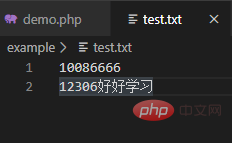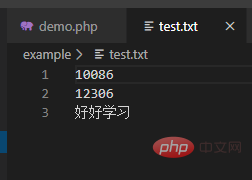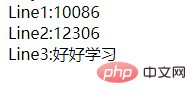How to read files in PHP? (Share summary)
In the previous article, I brought you "The exciting basics of regular expressions in PHP (detailed illustrations)", which mainly talked about the basic knowledge of PHP regular expressions and how to use them through examples. Learn how to use it. This article continues to learn about the PHP file system. I hope to be helpful!

When we use the computer, we all use the computer to open and close a file, create a file or upload a file. So can these operations be done in code? If it can be done, how should it be done? In fact, it is very simple. Learning file processing is actually learning the functions of file processing and combining it with what you have learned before. So let’s take a look next.
Reading files can be regarded as one of the most common operations in our daily use, so how to implement it in the code.
The following will introduce how to use functions in PHP to read file contents.
fgetc(): Read a character from a file
Before using these functions to read a file, We need to first create a text file in the server root directory (here we take text.txt as an example). The text content is as follows:

Let’s take a look. How should fgetc() be used and what is the output result:
<?php
header("Content-Type: text/html;charset=utf-8");
$handle = fopen('test.txt', 'r');
$a = fgetc($handle) ;
echo $a;
?>Output result:

fgetc can only read Taking a character, we can use the loop mentioned before to combine it, and we can get the following example:
<?php
header("Content-Type: text/html;charset=utf-8"); //设置字符编码
$handle = fopen('test.txt', 'r'); //打开文件
if (!$handle) { //判断文件是否打开成功
echo '文件打开失败!';
}
while (false !== ($char = fgetc($handle))) { //循环读取文件内容
echo $char;
}
fclose($handle); //关闭文件
?>Output result:

fgets() and fgetss(): Read the file line by line
<?php
header("Content-Type: text/html;charset=utf-8");
$handle = fopen('test.txt', 'r');
$a = fgets($handle) ;
echo $a;
?>Output result:

The fgetss() function is a variant of fgets() and is also used to read a row of data. It will also filter while reading. Remove the PHP and HTML tags in the read content.
It can be seen that the file can be read line by line through fgets. At the same time, as above, we can use a loop to read all files.
The example is as follows:
<?php
$handle = @fopen("test.txt", "r");
if ($handle) {
while (($info = fgets($handle, 1024)) !== false) {
echo $info.'<br>';
}
fclose($handle);
}
?>Output result:

##fread(): Read the file (any length)
##
<?php
$filename = "test.txt";
$handle = fopen($filename, "r");
$contents = fread($handle, '6');
echo '从文件中读取 6 个字符长度:'.$contents.'<br>';
rewind($handle);
$contents = fread($handle, filesize($filename));
echo '读取全部的文件内容:'.$contents;
fclose($handle);
?> Output result:
Output result: 
readfile(): Read all files <?php
$file = 'test.txt';
$info = readfile($file);
?>

file(): Read the entire file into an array <?php
$file = 'test.txt';
$arr = file($file, FILE_IGNORE_NEW_LINES);
$arr2 = file($file);
echo '<pre class="brush:php;toolbar:false">';
var_dump($arr);
var_dump($arr2);
?>

##file_get_contents(): Read the file into a string First, we First create a test.txt file
and then enter: 
<?php
$a = 'test.txt';
$b = file_get_contents($a);
//因为每一行有一个回车即\n,我用\n来把这个字符串切割成数组
$c = explode("\n", $b);
//把切割成的数组,下标赋值给$key,值赋值给$val,每次循环将$key加1。
while (list($key, $val) = each($c)) {
++$key;
$val = trim($val);
//用的单引号,单引号不解释变量进行了拼接而已
print 'Line' . $key .':'. $val.'<br />';
}
?>This is the integration of the knowledge we learned. First, we opened the file through file_get_contents, and then obtained the output results through the list each statement and while loop. 
The above file_get_contents method of opening a file is simple and crude, then the next Several
resource fopen ( string $文件名, string 模式) string fread ( resource $操作资源, int 读取长度) bool fclose ( resource $操作资源 )
- Use Related functions perform operations
- Close resources
fopen function The function of the fopen function is to open a file. There are two main parameters:
The path to open the file
-
Open file mode
The return type is a resource type, and the resource type requires other functions to operate this resource. All resources must be closed when they are opened.
fread function: The function of the function is to read the open file resource. Read the file resource of the specified length, read part of it and move part backward. to the end of the file.
fclose function: The function of fclose function is to close resources. Resources are opened and closed.
Next, I will introduce to you the mode of the fopen function:
rOpen in read-only mode and point the file pointer to the file header.rOpen in read-write mode and point the file pointer to the file header.wOpen the writing mode, point the file pointer to the file header and cut the file size to zero. If the file does not exist, try to create itwOpen in read-write mode, point the file pointer to the file header and truncate the file size to zero. If the file does not exist, try to create it.#aOpen in writing mode and point the file pointer to the end of the file. If the file does not exist, try to create itaOpen it in read-write mode and point the file pointer to the end of the file. If the file does not exist, try to create itxCreate and open it for writing, pointing the file pointer to the file header. If the file already exists, the fopen() call fails and returns FALSE and generates an E_WARNING level error message. If the file does not exist, try to create itxCreate and open it in read-write mode, pointing the file pointer to the file header. If the file already exists, the fopen() call fails and returns FALSE and generates an E_WARNING level error message. If the file does not exist, try to create it
Recommended learning: "PHP Video Tutorial"
The above is the detailed content of How to read files in PHP? (Share summary). For more information, please follow other related articles on the PHP Chinese website!

Hot AI Tools

Undresser.AI Undress
AI-powered app for creating realistic nude photos

AI Clothes Remover
Online AI tool for removing clothes from photos.

Undress AI Tool
Undress images for free

Clothoff.io
AI clothes remover

Video Face Swap
Swap faces in any video effortlessly with our completely free AI face swap tool!

Hot Article

Hot Tools

Notepad++7.3.1
Easy-to-use and free code editor

SublimeText3 Chinese version
Chinese version, very easy to use

Zend Studio 13.0.1
Powerful PHP integrated development environment

Dreamweaver CS6
Visual web development tools

SublimeText3 Mac version
God-level code editing software (SublimeText3)

Hot Topics
 PHP 8.4 Installation and Upgrade guide for Ubuntu and Debian
Dec 24, 2024 pm 04:42 PM
PHP 8.4 Installation and Upgrade guide for Ubuntu and Debian
Dec 24, 2024 pm 04:42 PM
PHP 8.4 brings several new features, security improvements, and performance improvements with healthy amounts of feature deprecations and removals. This guide explains how to install PHP 8.4 or upgrade to PHP 8.4 on Ubuntu, Debian, or their derivati
 7 PHP Functions I Regret I Didn't Know Before
Nov 13, 2024 am 09:42 AM
7 PHP Functions I Regret I Didn't Know Before
Nov 13, 2024 am 09:42 AM
If you are an experienced PHP developer, you might have the feeling that you’ve been there and done that already.You have developed a significant number of applications, debugged millions of lines of code, and tweaked a bunch of scripts to achieve op
 How To Set Up Visual Studio Code (VS Code) for PHP Development
Dec 20, 2024 am 11:31 AM
How To Set Up Visual Studio Code (VS Code) for PHP Development
Dec 20, 2024 am 11:31 AM
Visual Studio Code, also known as VS Code, is a free source code editor — or integrated development environment (IDE) — available for all major operating systems. With a large collection of extensions for many programming languages, VS Code can be c
 Explain JSON Web Tokens (JWT) and their use case in PHP APIs.
Apr 05, 2025 am 12:04 AM
Explain JSON Web Tokens (JWT) and their use case in PHP APIs.
Apr 05, 2025 am 12:04 AM
JWT is an open standard based on JSON, used to securely transmit information between parties, mainly for identity authentication and information exchange. 1. JWT consists of three parts: Header, Payload and Signature. 2. The working principle of JWT includes three steps: generating JWT, verifying JWT and parsing Payload. 3. When using JWT for authentication in PHP, JWT can be generated and verified, and user role and permission information can be included in advanced usage. 4. Common errors include signature verification failure, token expiration, and payload oversized. Debugging skills include using debugging tools and logging. 5. Performance optimization and best practices include using appropriate signature algorithms, setting validity periods reasonably,
 PHP Program to Count Vowels in a String
Feb 07, 2025 pm 12:12 PM
PHP Program to Count Vowels in a String
Feb 07, 2025 pm 12:12 PM
A string is a sequence of characters, including letters, numbers, and symbols. This tutorial will learn how to calculate the number of vowels in a given string in PHP using different methods. The vowels in English are a, e, i, o, u, and they can be uppercase or lowercase. What is a vowel? Vowels are alphabetic characters that represent a specific pronunciation. There are five vowels in English, including uppercase and lowercase: a, e, i, o, u Example 1 Input: String = "Tutorialspoint" Output: 6 explain The vowels in the string "Tutorialspoint" are u, o, i, a, o, i. There are 6 yuan in total
 How do you parse and process HTML/XML in PHP?
Feb 07, 2025 am 11:57 AM
How do you parse and process HTML/XML in PHP?
Feb 07, 2025 am 11:57 AM
This tutorial demonstrates how to efficiently process XML documents using PHP. XML (eXtensible Markup Language) is a versatile text-based markup language designed for both human readability and machine parsing. It's commonly used for data storage an
 Explain late static binding in PHP (static::).
Apr 03, 2025 am 12:04 AM
Explain late static binding in PHP (static::).
Apr 03, 2025 am 12:04 AM
Static binding (static::) implements late static binding (LSB) in PHP, allowing calling classes to be referenced in static contexts rather than defining classes. 1) The parsing process is performed at runtime, 2) Look up the call class in the inheritance relationship, 3) It may bring performance overhead.
 What are PHP magic methods (__construct, __destruct, __call, __get, __set, etc.) and provide use cases?
Apr 03, 2025 am 12:03 AM
What are PHP magic methods (__construct, __destruct, __call, __get, __set, etc.) and provide use cases?
Apr 03, 2025 am 12:03 AM
What are the magic methods of PHP? PHP's magic methods include: 1.\_\_construct, used to initialize objects; 2.\_\_destruct, used to clean up resources; 3.\_\_call, handle non-existent method calls; 4.\_\_get, implement dynamic attribute access; 5.\_\_set, implement dynamic attribute settings. These methods are automatically called in certain situations, improving code flexibility and efficiency.






